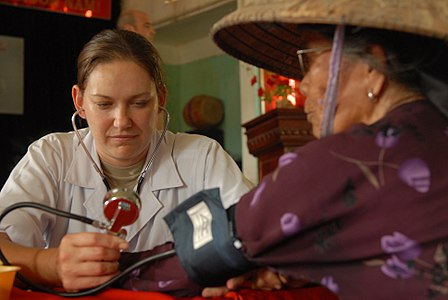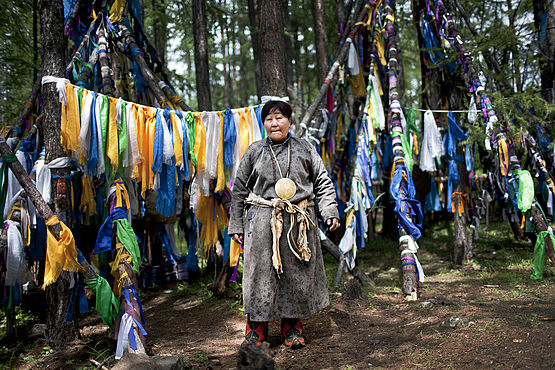Cultural Anthropology/Social Institutions/Illness, Healing, Death & Dying
Contents
Health & Illness
Key Terms & Concepts
- Medical anthropology
- Applied anthropology
- Health
- Disease
- Illness
- Health system
- Disease theories: personalistic, naturalistic, emotionalistic
- Health system theories: ecological/epidemiological, interpretivist, critical medical anthropology
- Ethnomedicine
- Ethno-etiology
- Structural suffering
- Culture-bound syndromes
- Community healing
- Humoral healing
Medical anthropology is the research area within cultural anthropology that marries concepts from biological and cultural anthropology to better understand health and disease among humans. It is one of the fastest growing research areas within anthropology. Some would classify it as part of applied anthropology. Applied anthropologists use anthropological research methods and results to “identify, assess, and solve contemporary problems” (Gezen and Kottak 2014: 240). Applied anthropologists are found in many areas of work, including public health, economic development, forensics, linguistics, and human rights, in both rural and urban settings across the globe. For decades, anthropologists have been studying the interaction of cultural values and norms on health-related issues. In recent years, Western medical practitioners are beginning to use anthropological data to better understand their multicultural patients’ responses to “modern” health care practices.
Defining Health and Illness
In order to understand the anthropological approach to health and illness, it is necessary to know the definitions of terms related to the topics.
All definitions of health are imbued with moral, ethical, and political implications. Perhaps the broadest definition of health is that proposed by the World Health Organization (WHO), defining health with reference to an “overall sense of well-being.” By WHO’s criteria, only a relatively small percentage of the world’s population could be classified as healthy (Glazier and Hallin 2010: 925).
Disease and illness are separate concepts. Disease is a condition caused by a pathogen, e.g., bacterium, parasite, or virus, which has been scientifically verified; it is something that can be objectively measured. These can vary by group (e.g., ethnicity and socioeconomic status), geography, incidence, and severity. Illness is a feeling or perception of not being healthy. Illness may be caused by disease, but it can also be caused by psychological or spiritual factors and tied to an individual’s worldview. Health systems include cultural perceptions and classification of health-related issues, healing practices, diagnosis, prevention, and healers (Miller 2011).
Theoretical Approaches
Anthropologists George Foster and Barbara Anderson, who together with Khwaja Hassan, established the field of medical anthropology, identified three disease theory systems that explain illness:
- Personalistic disease theory: Illness is due to the action of an agent such as a witch, sorcerer, or supernatural entity, e.g., ancestor spirit or ghost. Healers must use supernatural means to learn the cause and to help cure illness.
- Emotionalistic disease theory: Illness is due to a negative emotional experience. For many living in Latin American countries, anxiety or fright may cause lethargy and distraction, an illness called susto. Psychotherapists are interested in the role emotions play in physical health.
- Naturalistic theory: Illness is due to an impersonal factor, e.g., pathogen, malnutrition, obstruction (e.g., kidney stone), or organic deterioration (e.g., heart failure). Naturalistic theory has its origins in the work of Hippocrates and dominates the pedagogy of modern medical schools.
Barbara Miller (2011) outlines three theoretical approaches that attempt to understand health systems:
- Ecological/Epidemiological Approach: This approach aims to produce data that can be used by public health programs by focusing how the interaction of the natural environment and culture can cause health problems and influence their spread through a population.
- Interpretivist Approach: Drawing on the work of Claude Lévi-Strauss, the interpretivist approach examines how community and individual distress is alleviated through healing systems and how illness is defined and experienced. The assumption is that the healing system provides meaning for suffering.
- Critical Medical Anthropology: Critical medical anthropologists examine how health systems are impacted by structural elements, e.g., social inequality, political economy, global media, etc.
Ethnomedicine
The cross-cultural study of health systems is called ethnomedicine. It goes beyond examination of health systems to look at such things as the impact of globalization on the health system as well as cultural concepts of the body and disability and the use of plants and animals within the health system. Early ethnomedicine studies focused on the health systems of indigenous peoples across the globe. More recently Western biomedical practices are identified as an ethnomedicine and included in the scope of ethnomedicine studies.
All people try to understand the cause of illness and disease. The cross-cultural study of specific causal explanations for health-related problems is called ethno-etiology. Ethno-etiological studies of migraines demonstrate that in the Bahia area of Brazil, certain types of winds are the causal explanation of migraines. In the U.S., biomedical explanations for migraines include emotional stress, sensitivity to certain chemicals and preservatives in food, excessive caffeine, menstrual periods, skipping meals, changes in sleep patterns, excessive fatigue, changing weather conditions, and numerous medical conditions such as hypertension, asthma, and chronic fatigue syndrome.
Structural suffering, or social suffering resulting from poverty, famine, conflict, and forced migration, is a focus of ethnomedicine and medical anthropology in general. Frequently, structural suffering is related to culture-bound syndromes, which are psychopathologies (suite of signs and symptoms) restricted to certain cultural environments. Witiko is a culture-bound syndrome found among indigenous peoples of Canada. The symptoms include an aversion to food accompanied by depression and anxiety. The witiko spirit, which is a giant human-eating monster, eventually possesses the inflicted individual causing the person to acts of cannibalism and homicide. Studies indicate that witiko is an extreme form of starvation anxiety (Martin 2012). Other examples of culture-bound syndromes that are not necessarily related to structural suffering include:
- Amok afflicts males in Indonesia, Malaysai, and Thailand. The term means ‘to engage furiously in battle.’ Symptoms include wild, aggressive behavior. The inflicted first withdraws or broods then attempts to kill or hurt another person until they are restrained, exhausted, or killed. The condition is caused by loss of either social or economic status, a loved one, or a real or perceived insult (Gomez 2006).
- Anorexia nervosa: a culture-bound syndrome associated with affluent industrial societies. It is an eating disorder characterized by self-starvation. Affecting primarily women, anorexia nervosa is associated with cultures that place excessive value on female thinness. Contributing factors include over-controlling parents and socially, economically upwardly mobile family, earl onset of puberty, tallness, low self-esteem, depression, and some illnesses like juvenile diabetes (Strickland, ed. 2001). It may also be related to "religious idioms and symbols about the body, food, and self" (Banks 1992: 867.
- Hwa-byung, meaning fire disease, occurs in Korea. Eastern medicine relates its cause to an imbalance between yin (negative force) and yang (positive force) or between ki (vital energy) and hwa (illness with properties of fire). Western biomedicine attributes it to incomplete suppressed anger or projection of anger into the body. Symptoms include feelings of frustration, anxiety, guilt, fear, humiliation, hatred, depression, and disappointment. Physical manifestations are many, including palpitations, indigestion, dizziness, nausea, constipation, pain, insomnia, and more. Individuals suffering from hwa-byung may be abnormally talkative, short-tempered, absent-minded, paranoid, and have suicidal thoughts (Park 2006).
- Latah has been found predominantly in Malaysia, but similar syndromes occur in the Philippines (mali-mali), Burma (yaun), and among indigenous peoples in Siberia (myriachif) and Japan (imo). Caused by a sudden shock, e.g., death of a loved one, or fright, the individual enters a dissociative, highly suggestible state where they readily follow the commands of others. They often suffer from echolalia when they compulsively repeat what others say, or echopraxia when they mimic the actions of others. Socially inappropriate behaviors are common with this syndrome, including touching or hitting others, saying sexually explicit things, and singing out loud (Legerski 2006).
Healing & Healers
In the Western biomedical approach to healing, private healing is the norm; oftentimes only the patient and the professional health practitioner(s) is/are in the room. In other health systems community healing or humoral healing are common. The community healing approach considers social context critical for the healing process. Healing practices take place in front of the whole community and often involve their participation. One example is the healing dance of Ju/hoansi foragers of the Kalahari. Several times a month, the healing dance is performed to draw on the collective energy of the participants. Men, and sometimes women, dance around a circle of women who sit around a fire, clapping and singing. Healers draw on the spiritual energy of the dancers and singers to enhance their consciousness. During this period of enhanced consciousness, healers can heal those in need (Miller 2011).
Humoral healing systems use a philosophy centered on the idea that heat and coolness imbalances in the body cause disease. Coolness causes death in some Chinese, Indian, and Islamic cultures while in others such as the Orang Asli in Malaysia heat is the culprit. Food and drugs are used to offset these imbalances.
Healing is generally done through a combination of informal methods, e.g., self-diagnosis and treatment, and formal treatment using a healing specialist. There are many different types of healing specialists:
- Shamans and shmankas,
- Midwives,
- Bonesetters,
- Doctors,
- Nurses,
- Dentists,
- Chiropractors,
- Herbalists,
- Psychiatrists and psychologists, and
- Acupuncturists.
All healing specialists go through similar process to become specialists. First there is the selection process. In most cases, the candidate must show some aptitude. In an indigenous society it might be an ability to connect with the supernatural realm. In cultures reliant on the Western biomedical approach, candidates must pass entry exams and academic courses to become specialists. Training from seasoned healing specialists is a key component for all those who wish to become a healing specialist whether in the form of an apprenticeship with a shaman to formal training in a medical school. Training can be arduous both physically and mentally no matter the type of training. Once training is complete, the candidate earns a medical degree in the Western biomedical system. In indigenous societies, initiation rituals are performed. Once this certification process is complete, the healing specialist can adopt the raiment of the professional healer, e.g., the white coat of the medical doctor. Payment is generally expected for services rendered. What constitutes payment is highly variable, from salaries to livestock.
Explore: Learn more about the anthropologists
References
Ancis, Julie R. “Culture-Bound Syndromes.” In Encyclopedia of Multicultural Psychology, edited by Yo Jackson, p. 130-132. Thousand Oaks, CA: SAGE Reference, 2006.
“Anorexia.” In The Gale Encyclopedia of Psychology, edited by Bonnie Strickland, p. 37-38. Detroit: Gale, 2001.
DeWalt, Kathleen Musante. “Anthropology, Medical.” In International Encyclopedia of the Social Sciences, Vol. 1, edited by William A. Darity, Jr., p. 130-132. Detroit: Macmillan Reference USA, 2008.
Foster, George M. and Barbara G. Anderson. Medical Anthropology. New York: McGraw-Hill, 1978.
Gaines, Atwood D. “Ethnomedicine.” In Encyclopedia of Anthropology, Vol. 2, edited by H. James Birx, p. 859-861. Thousand Oaks, CA: SAGE Publications, 2006.
Glazier, Stephen D. and Mary J. Hallin. “Health and Illness.” In 21st Century Anthropology: A Reference Handbook, Vol. 2, edited by H. James Birx, p. 925-935. Thousand Oaks, CA: SAGE Reference, 2010.
Gomez, Michael. “Culture-Bound Syndromes: Amok.” In Encyclopedia of Multicultural Psychology, edited by Yo Jackson, p. 132. Thousand Oaks, CA: SAGE Reference, 2006.
Legerski, John-Paul. “Culture-Bound Syndromes: Latah.” In Encyclopedia of Multicultural Psychology, edited by Yo Jackson, p. 139-140. Thousand Oaks, CA: SAGE Reference, 2006.
Martin, Kimberly. “Examples of Culture-Bound Syndromes.” Kimberly Martin, PhD. Accessed April 23, 2015. http://www.kimberlymartin.com/wp-content/uploads/2012/08/Culture-bound-Syndromes.pdf.
“Migraines and Headaches.” WebMd. Accessed April 23, 2015. http://www.webmd.com/migraines-headaches/guide/migraines-headaches-migraines#2.
Miller, Barbara. Cultural Anthropology, 6th edition. Boston: Prentice Hall, 2011.
O’Neil, Dennis. “Medical Anthropology: How Illness Is Traditionally Perceived and Cured Around the World.” Last updated February 8, 2012. http://anthro.palomar.edu/medical/default.htm.
Park, Young-Joo. “Culture-Bound Syndromes: Hwa-Byung.” In Encyclopedia of Multicultural Psychology, edited by Yo Jackson, p. 137-138. Thousand Oaks, CA: SAGE Reference, 2006.

